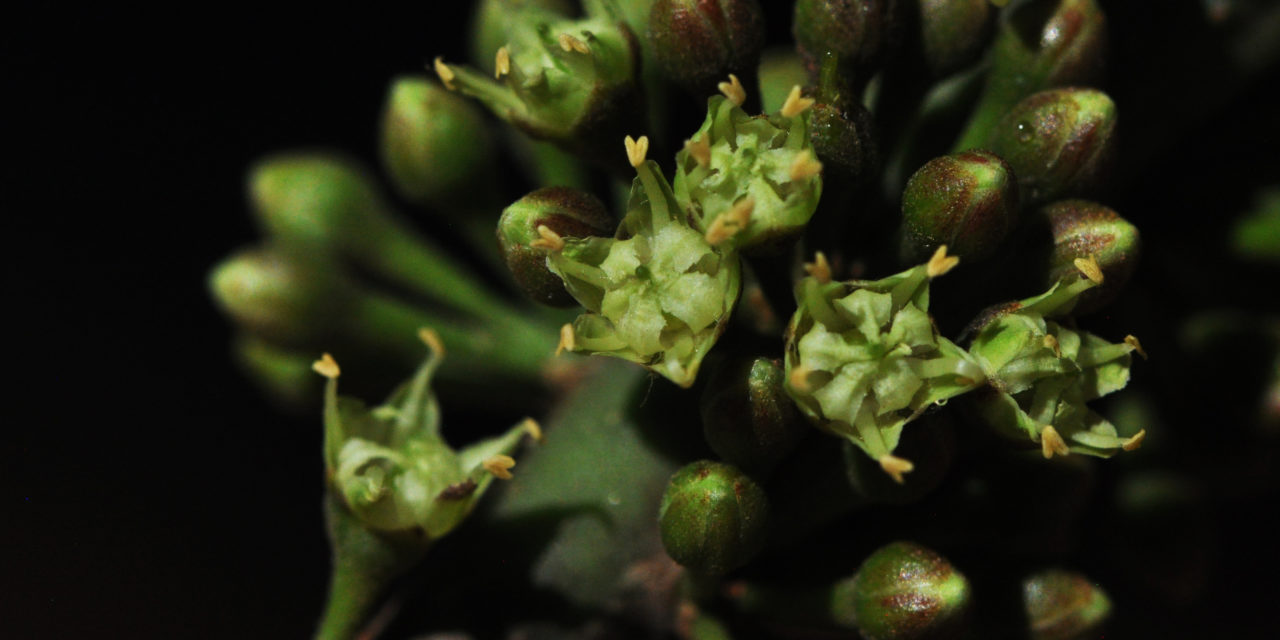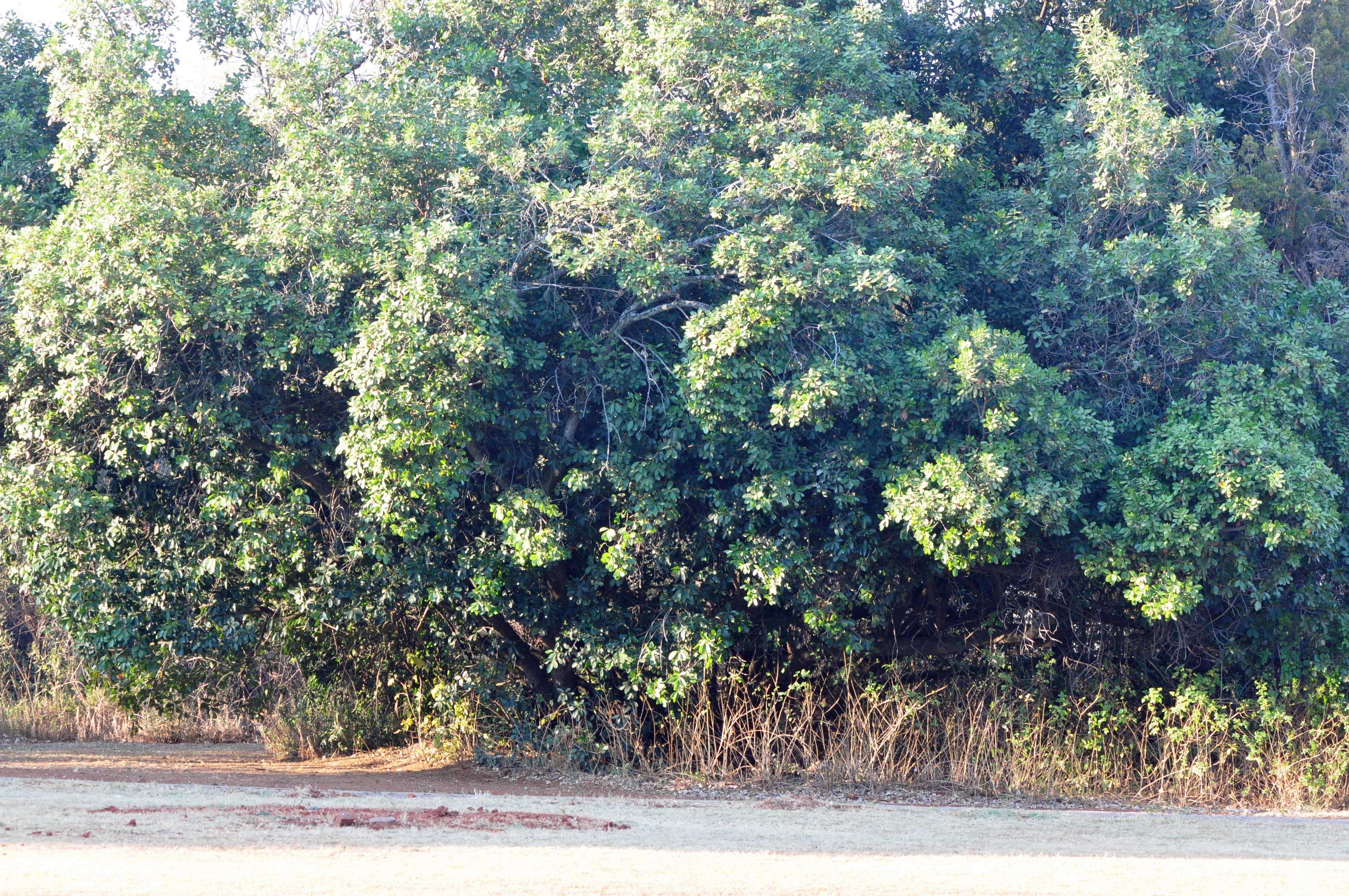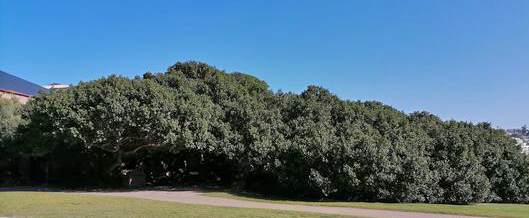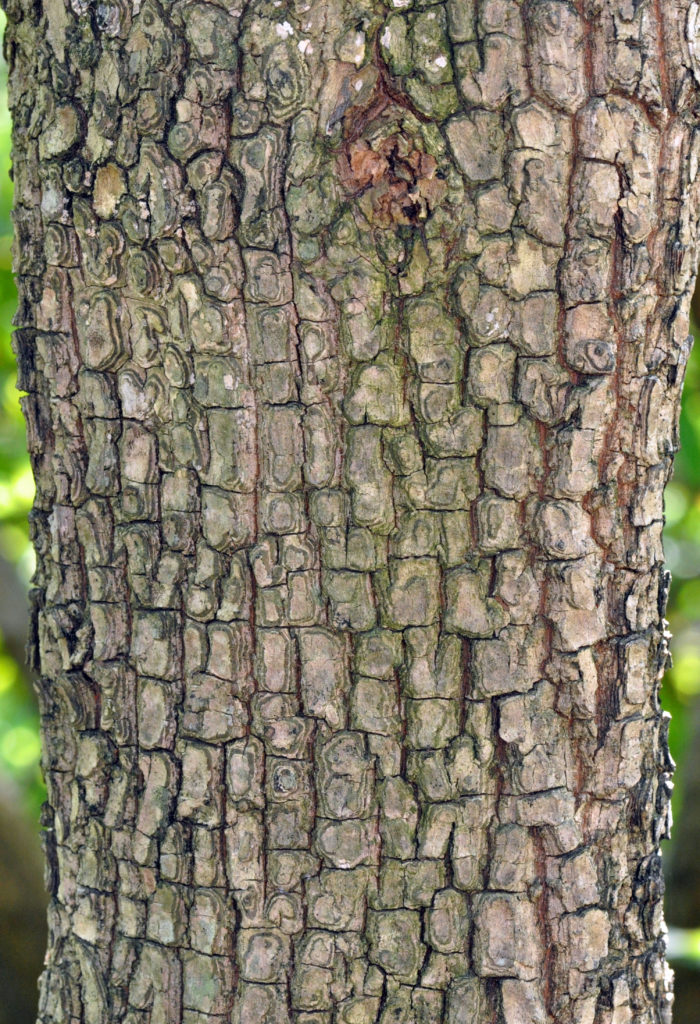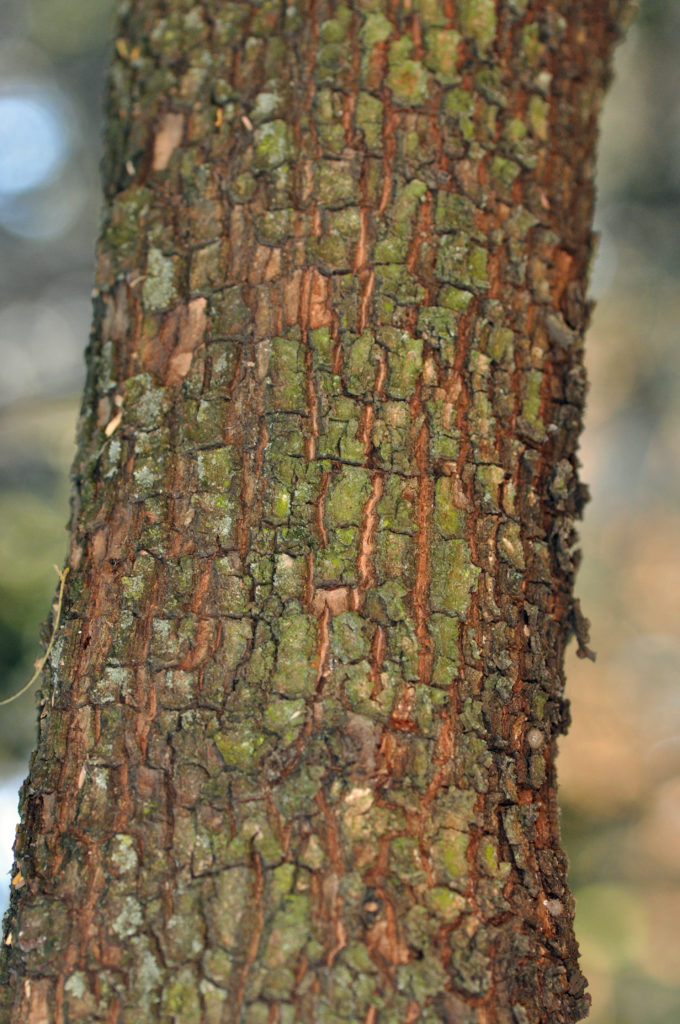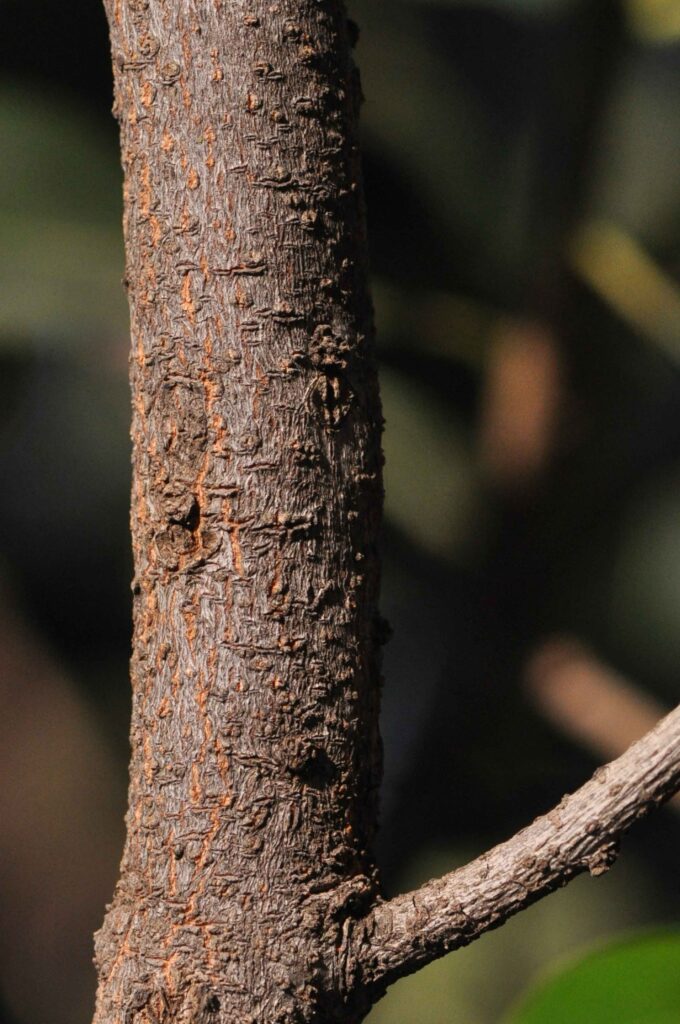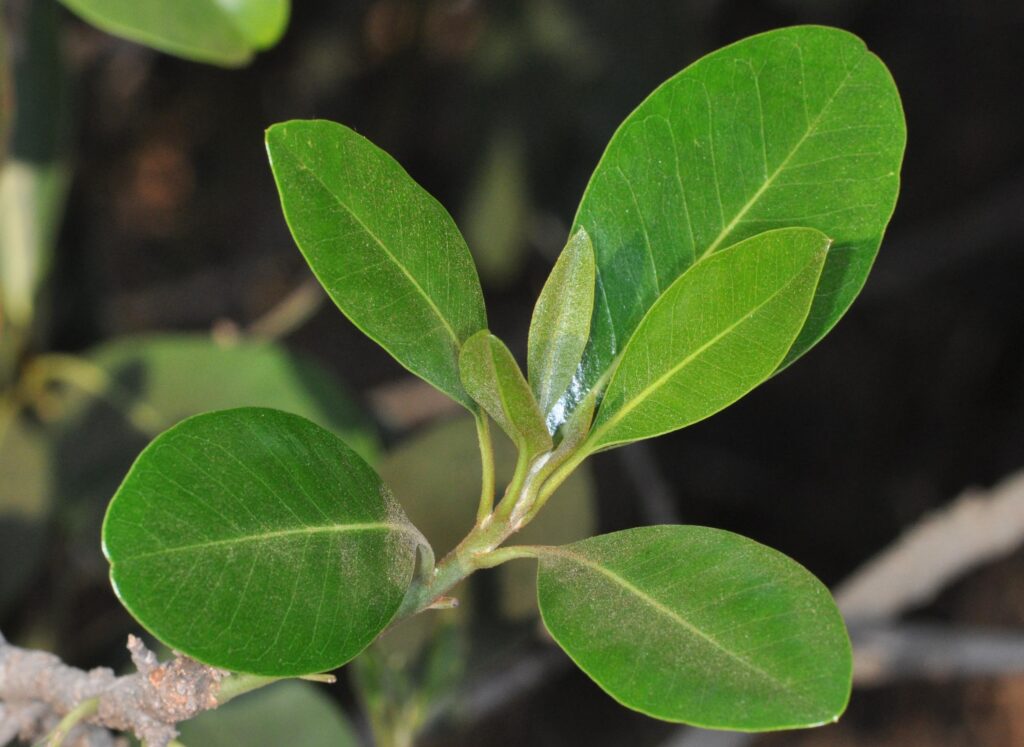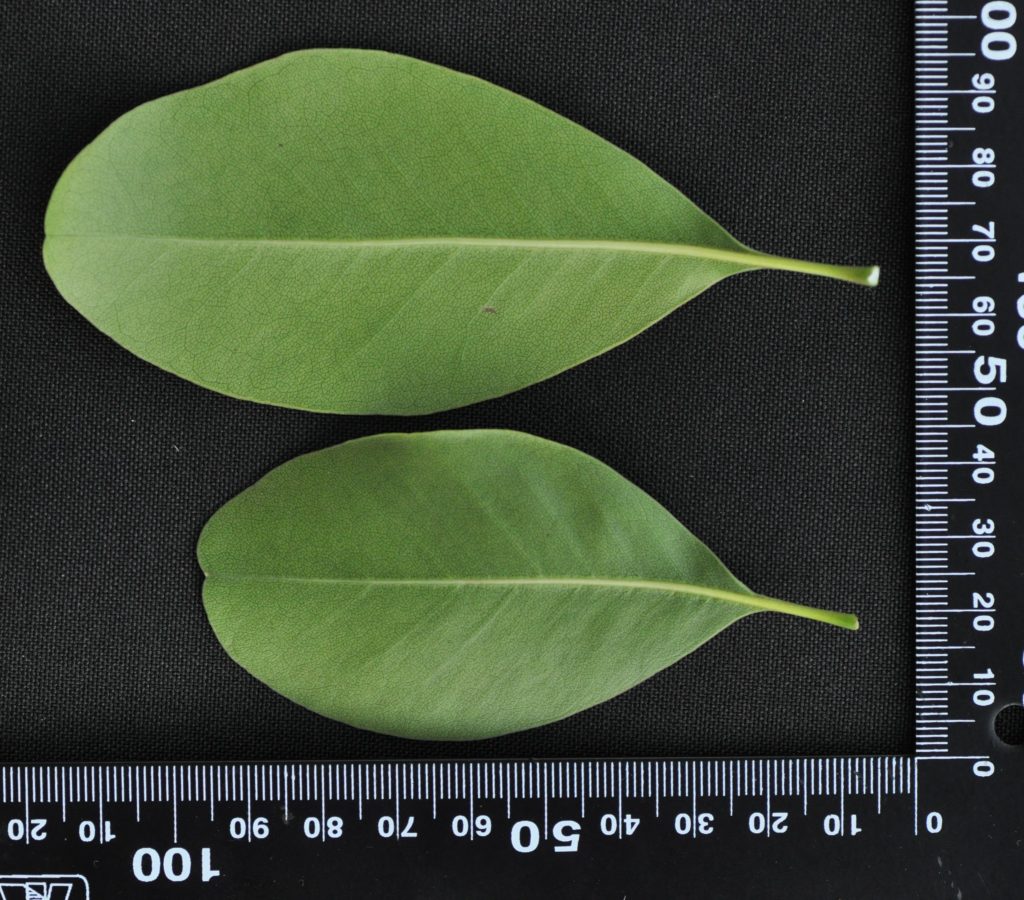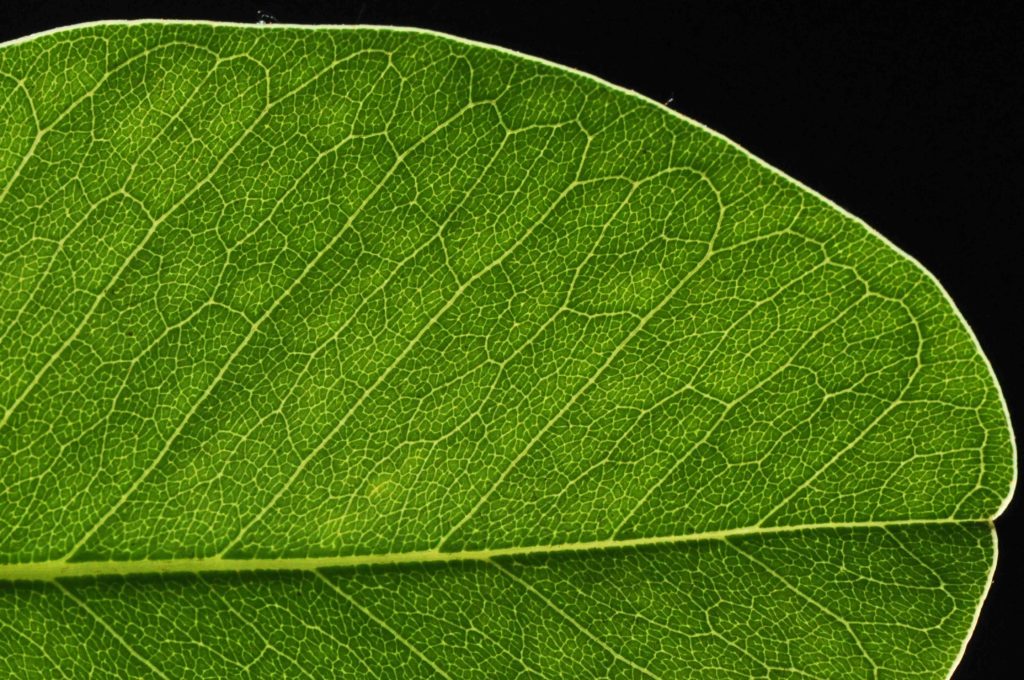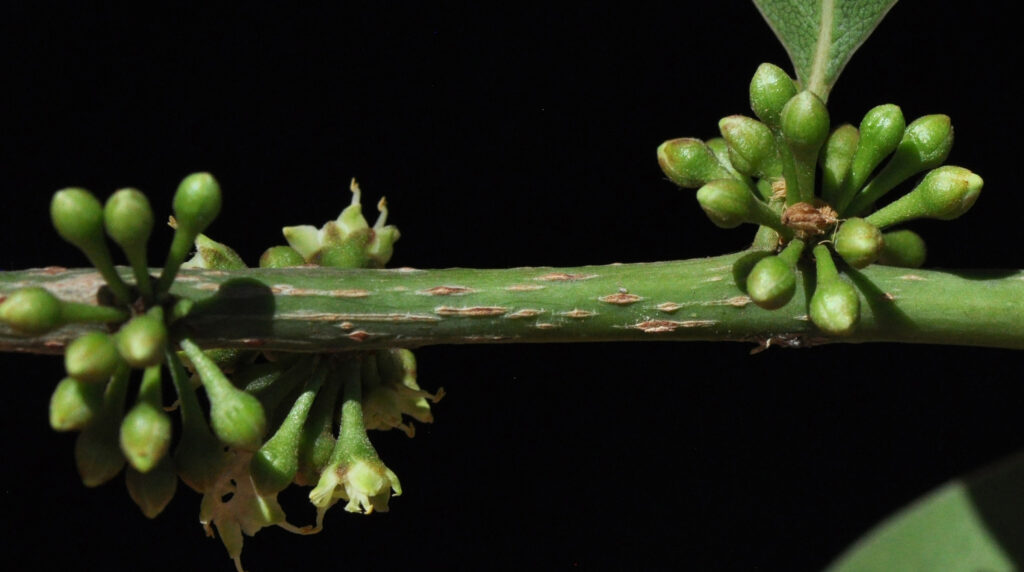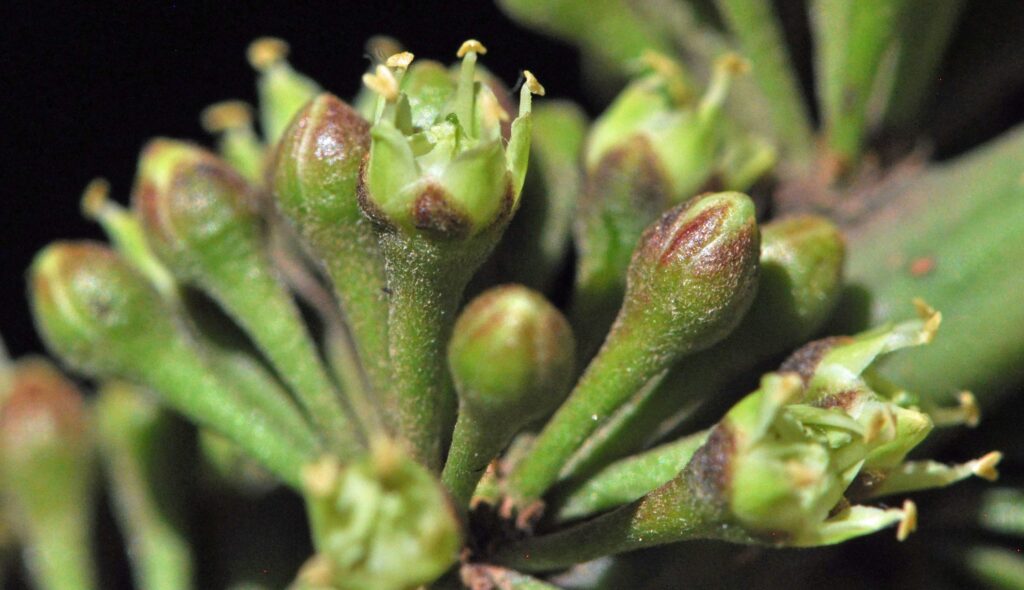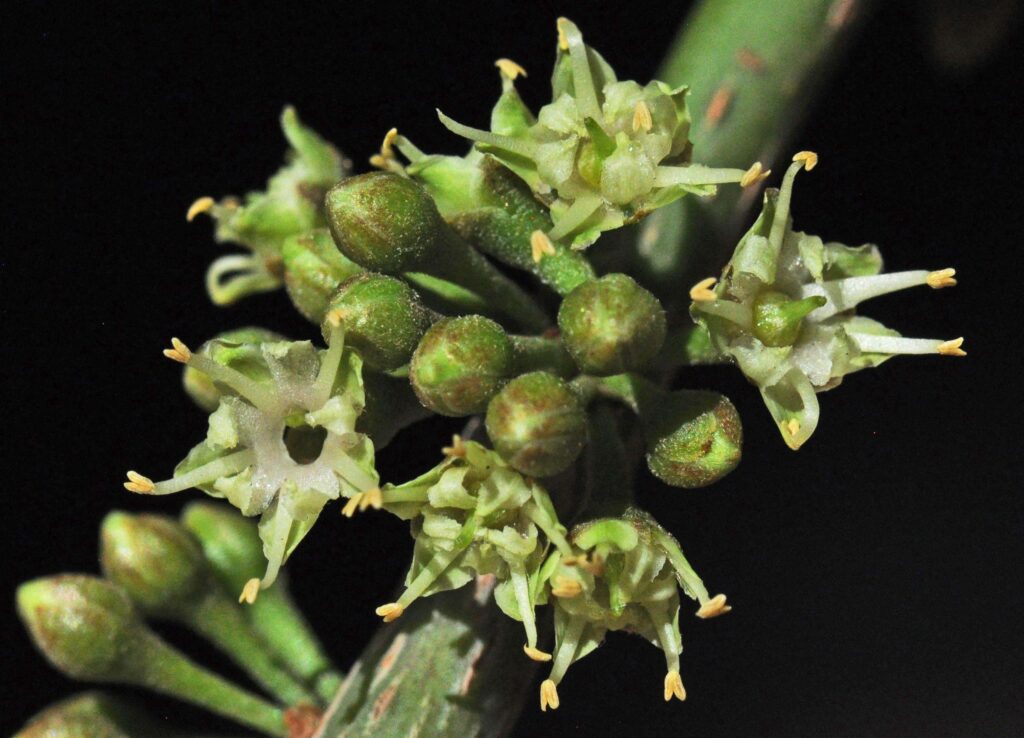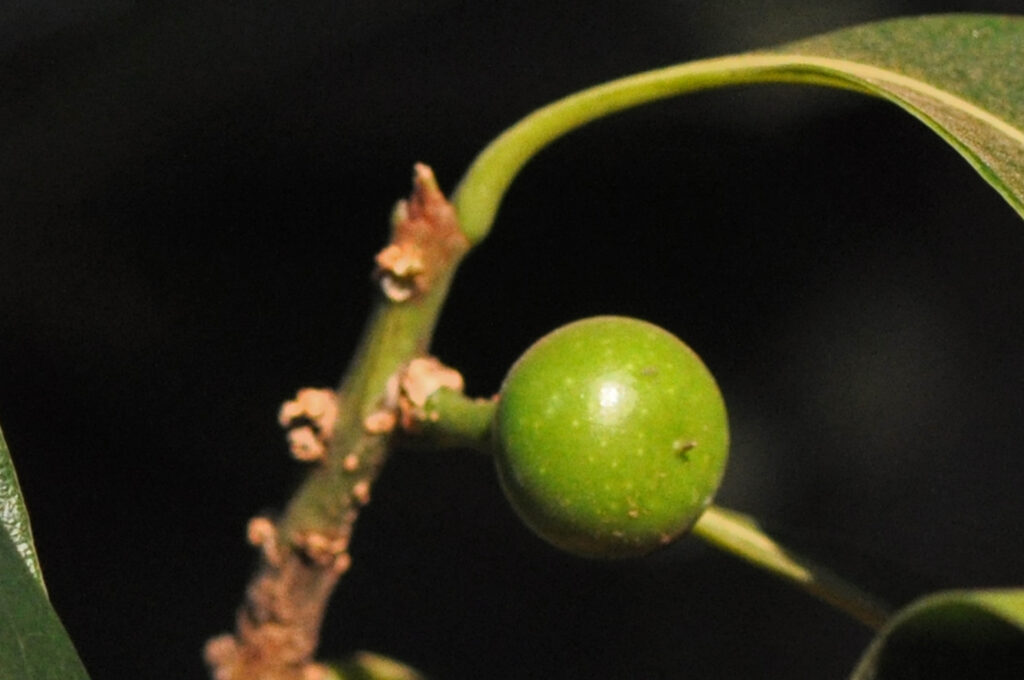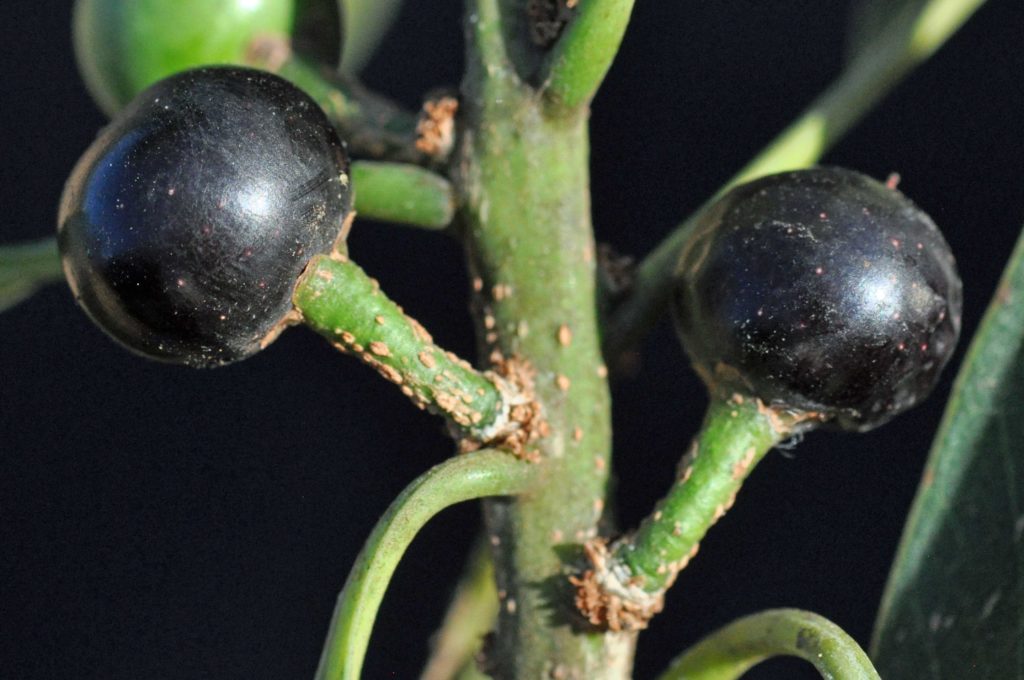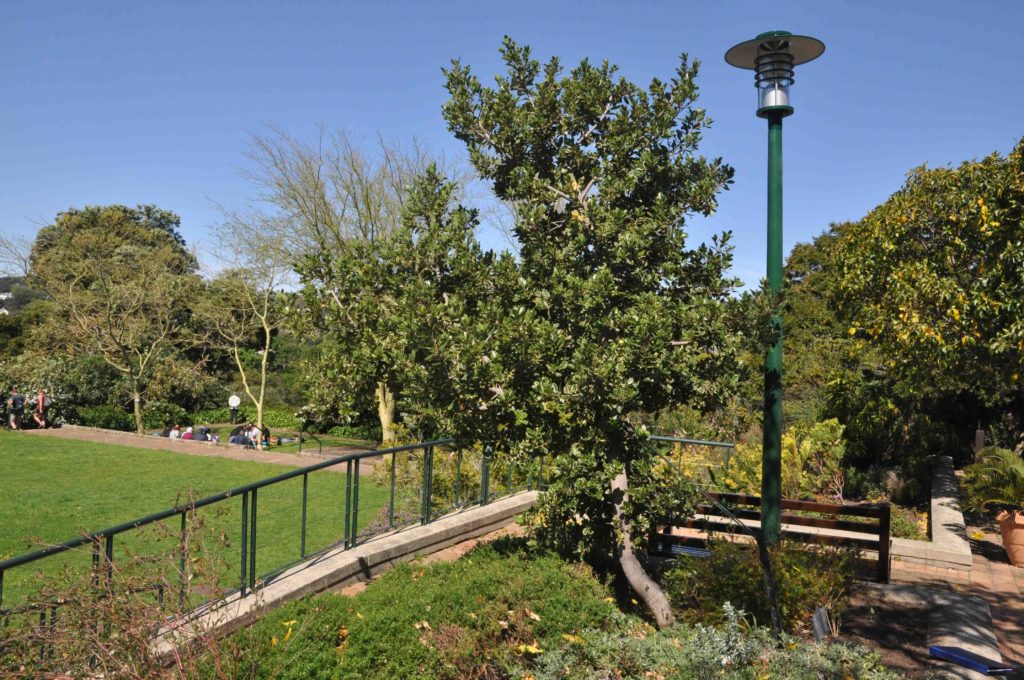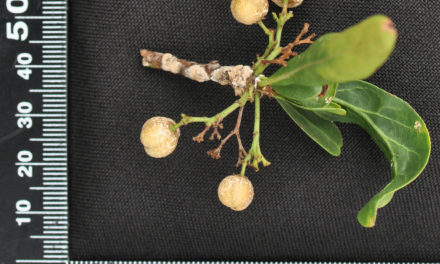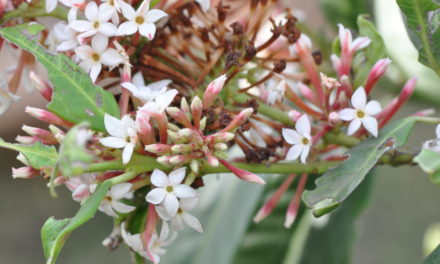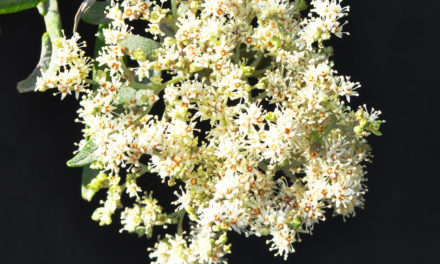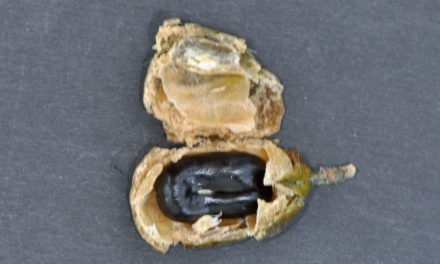General Info – summary
This latex containing evergreen and usually coastal Tree with a large, rounded crown may reach 18m+ high. The leathery Leaves lack stipules and are simple with lateral veins joining up before reaching the entire margin. Bisexual, regular, 5-merous, greenish white Flowers have yellow arrow shaped anthers. Ripe shiny Fruit is a fleshy black berry with sticky juice and one black seed.
Description
Sideroxylon inerme subsp. inerme
Previous Names: Calvaria inermis, Sideroxylon inerme L. var. schlechteri.
SA Tree No. 579.
Common names: (Afr) Jakkalsbessie, Melkbessie, Melkbessieboom, Melkbessiebos, Melkboom, Melkhout, Melkhoutboom, Witmelkhout. (Eng) Sea Oak, White Milkwood. (isiXhosa) Amasethole, Umqwashu, Umnweba, Ximafana. (isiZulu) Amasethole, Amasethole-amhlophe, Umaphipha, Umakhwela-finqane, Umhahle, Umakhwela-fingqane, Umbhobe. (siSwati) Emaselitfole, Umnweba. (Tshivenda) Mutaladzi-vhufa.
Family: Sapotaceae. (Stamvrug, latex-yielding family). This family is pantropical (distributed throughout the tropics) and includes 35-75 genera and approximately 800 species. Local genera with trees on this website include Englerophytum, Inhambanella, Mimusops, Sideroxylon and Vitellariopsis. Branches exude latex. Leaves are simple, entire and there are closely parallel secondary veins. Stipules are absent. Flowers are bisexual, usually actinomorphic (regular). There are persistent Sepals and fused Petals. The Stamens equal the number of petals. Staminodes may be present outside the fertile stamens. The superior Ovary has locules containing a single ovule. One Style and 1 Stigma are present. Fruit is a berry. Seeds have a thick brown shiny testa (seed coat) with a distinct pale scar. Seeds dispersed by birds, bats and mammals. There are 7 genera and 14 species in southern Africa.
Name derivation: Sideroxylon – sideros (iron) + xylon (wood): referring to the hardness of the timber. inerme – unarmed – referring to fact that the tree lacks spines. Sideroxylon inerme is the only species in southern Africa. This is not the easiest tree to identify.
Conservation: National Status: L C. (Least Concern). Assessment: 2005 (W. Foden and L. Potter).
Tree
Portuguese mariners used the historically significant Mossel Bay Post Office Tree (Sideroxylon inerme) as a post office more than 500 years ago (photo 85). It still stands today and is a proclaimed monument. With its large dense rounded crown, this milky Tree is usually up to 10m high but may reach 18m. The sturdy trunk has a diameter up to 40cm. The main sturdy crooked Stem and branches may be upright, at an angle or twisted. The Bark is initially smooth and mottled but becomes rough, grey-brown to black and has rectangular cracks (photo 651). Red underbark may be visible between cracks (photo 422). Young branches are smooth or covered with a soft grey to rusty indumentum (a dense, fine hairy covering). Present here are Lenticels (a usually raised corky oval or elongated area on the plant that allows the uncontrolled interchange of gases with the environment – photo 484 under Flowers). Older branches may be gnarled (knobbly, rough, and twisted, especially with age). Trees may reach 500+ years old.
- 406. 2017/08/15. Pretoria NBG. Photo: David Becking.
- 85. 21/11/19. Mosel Bay Post Office Tree. Photo Hilton Westlake.
- 651. 2014/09/14. Lowveld NBG. Photo: David Becking.
- 422. 2017/08/15. Pretoria NBG. Photo: David Becking.
- 420. 2017/08/15. Pretoria NBG. Photo: David Becking.
Leaves
This evergreen tree has dense foliage. The Leaves are relatively smooth and simple (have a single blade that may have incisions that are not deep enough to divide the leaf into leaflets). The size is variable, and leaves are usually up to 11 x 5cm and exude milky latex when broken. Removal of the leaf prior to taking the picture (photo 412) shows milky latex escaping from the base of the petiole (leaf stalk). Hair falling from older leaves may leave untidy patches until the hairs fall or are rubbed off. Leaves are more or less elliptic or oblong to obovate. They are arranged spirally or alternately around twigs (photo 424). The Apex may be broadly tapering, rounded or notched (photo 412). The Base tapers. The Blade is leathery and smooth. The shiny Upper surface (photo 424) is a darker green and the Midrib is the most visible of the Veins. The midrib is yellow-green protrudes on both sides. Side veins link before reaching the margin. This detail is best observed when the leaf is viewed against a strong light (photo 13). Here a hand lens will help. Net veining is inconspicuous but does divide the surface into tiny polygonal spaces (photo 13). This is more visible in younger leaves. The lighter Lower surface may be covered with a soft grey to rusty indumentum (a dense, fine hairy covering). Until they all have fallen, some of these hairs may be rubbed off – giving an untidy appearance. The leaf Margin is slightly rolled under and is entire (with a continuous margin, not in any way indented). Older leaves change to a red colour. The Petiole (leaf stalk) has long rusty hairs when young and is up to 1,8cm long (photo 412). Stipules (basal appendage of the petiole) are absent.
- 424. 2017/08/15. Pretoria NBG. Photo: David Becking.
- 412. 2017/08/15. Pretoria NBG. Photo: David Becking.
- 13. 2019/09/27. Pretoria NBG. Photo: David Becking.
Flowers
The Flowers are actinomorphic (Regular, symmetrical. Flowers are vertically divisible into similar halves by more than 1 plane passing through the axis). They may occur solitary or in clusters. Flowers are small – up to 4mm long, greenish-white and strongly scented. Single or clusters of flowers, either occur in a dense axillary cluster (photo 484) of lower leaves or are on stems where the leaves have fallen. Short hairy Pedicels (stalks of single flowers) are present (photo 473). Each bisexual flower is 5-merous (floral parts are in 5’s) throughout. The Calyx has Sepals in a single whorl (photo 473). In the Corolla, the Petals have a well-developed tube. Stamens are epipetalous (born on or arising from the petals / corolla) and alternipetalous (positioned between the petals or lobes of the corolla). They extend beyond the petals and the initially yellow arrowhead shaped Anthers (photo 483) dehisce longitudinally. Strap-like or petaloid Staminodes (sterile stamens) that alternate with the petals may be visible. There is a single Pistil (a unit of the gynoecium composed of the stigma, style and ovary). Here the superior Ovary has one Ovule. Extending from the ovary is a single Style that ends in a single Stigma (photo 483). (Oct-Apr).
- 484. 2017/10/17. Pretoria NBG. Photo: David Becking.
- 473. 2017/10/17. Pretoria NBG. Photo: David Becking.
- 483. 2017/10/17. Pretoria NBG. Photo: David Becking.
Fruit
The fleshy Fruit is an almost spherical, pea-sized Berry (pulpy, indehiscent fruit like a grape or tomato) which is initially green and about 1,2cm in diameter (photo 418). It becomes purplish black when mature (photo 196). In this picture, two Pedicels (stalks of single flowers) are visible. A sticky white juice is present inside the berry. The persistent thread-like Style is still visible (photos 418 & 196). Milky latex is present in each berry, and a single black, almost spherical Seed, up to 9mm wide develops. The Testa (seed coat) is thick and bony. The 5-9mm wide, shiny seed has a basal circular scar, and tiny ribs that may be visible. The Seeds have plentiful endosperm (the starch and oil-containing tissue of many seeds; often referred to as the albumen). (Feb-Sep).
- 418RR 2017.08.15 Pretoria NBG. Photo: David Becking.
- 196 (2) 2017.10.08 Pretoria NBG. Photo: David Becking.
Distribution & Ecology
This is primarily a coastal tree, occurring in coastal woodlands and dune forests along the entire southern and eastern coast of South Africa. Further north in Gauteng and Zimbabwe they are found further inland. They occur in the Western Cape e.g. from close to Cape point, the Eastern Cape e.g. in the Amatola Mountains. These mountains are about 280km by 90km. Towns here include, Hogsback, King Williams Town and Stutterheim. These trees also occur in KwaZulu-Natal, Limpopo, Mpumalanga, Swaziland and southern Mozambique. In inland areas trees occur near streams, up to an altitude of 2 000m and is often associated with termite mounds. They are also located in the bushveld (a sub-tropical woodland ecoregion of southern Africa). Speckled mousebirds consume the Flowers, which also attract bees. Monkeys, bushpigs, bats and many fruit eating birds eat the Fruit. Nyala and kudu eat the Leaves.
- 454. 2018/09/16. Kirstenbosch NBG. Photo: David Becking.
- 453. 2018/09/16. Kirstenbosch NBG. Photo: David Becking.
Ethnobotany
This Tree is fire-resistant, and a planted hedge becomes an effective firebreak. The fine-grained, yellowish-brown Wood is dense, very hard, and durable in water and shrinks little on drying. It is used as a general-purpose timber including for making farm implements, fence poles, railway sleepers and good boat building. Once dried it makes a good firewood. This is now a protected tree in South Africa. The plant can be grown from Seeds which should first be removed from the berry, rinsed and dried before planting (+- November) in sandy soil. Germination takes at least a month. The sticky Fruit is edible. Research has indicated that Bark extracts may have skin-lightning properties. Local medicine makes good use of this tree. The plant is fire-resistant, and a planted hedge becomes an effective firebreak.
References
Boon, R. 2010. Pooley’s Trees of eastern South Africa. Flora and Fauna Publications Trust, Durban.
Burrows, J.E., Burrows, S.M., Lotter, M.C. & Schmidt, E. 2018. Trees and Shrubs Mozambique. Publishing Print Matters (Pty) Ltd. Noordhoek, Cape Town.
Coates Palgrave, M. 2002. Keith Coates Palgrave Trees of Southern Africa, edn 3. Struik, Cape Town.
Foden, W. & Potter, L. 2005. Sideroxylon inerme L. subsp. inerme. National Assessment: Red List of South African Plants version 2020.1. Accessed on 2024/01/10.
Lawrence, G. H. M, 1951. Taxonomy of Vascular Plants. The Macmillan Company, New York. Tenth Printing 1965.
Palmer, E. & Pitman, N. 1972. Trees of southern Africa. Balkema, Amsterdam, Cape Town.
Schmidt, S. Lotter, M. & McCleland, W. 2002. Trees and Shrubs of Mpumalanga and the Kruger National Park. Jacana, Johannesburg.
van Wyk, B. & van Wyk, P. 1997 Field guide to Trees of Southern Africa. Struik, Cape Town.
https://en.wikipedia.org/wiki/Sideroxylon_inerme
http://www.plantzafrica.com/plantqrs/sideroxinerm.htm
https://en.wikipedia.org/wiki/Amathole_Mountains#Interesting_towns

